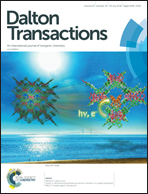Small molecule activation with divalent samarium triflate: a synergistic effort to cleave O2†
Abstract
The divalent samarium triflate salt does not react with CO2 or water, but does react with traces of O2 or N2O to form a tetrameric bis-oxo samarium motif. The reaction with O2 is a 4e− reductive cleavage where the electrons are coming from four different samarium centers. This highlights a rare synergistic effect for cleaving O2, which has no precedent in divalent lanthanide complexes. Additionally, the addition of CO2 to the tetrameric bis-oxo intermediate leads to the formation of a tetrameric bis-carbonate samarium triflate. Thus, the concomitant reaction of CO2 with traces of O2 leads to the same bis-carbonate tetrameric assembly.



 Please wait while we load your content...
Please wait while we load your content...